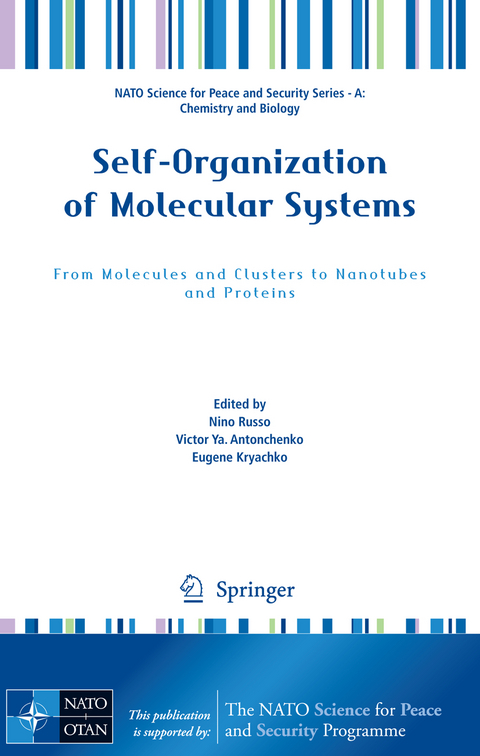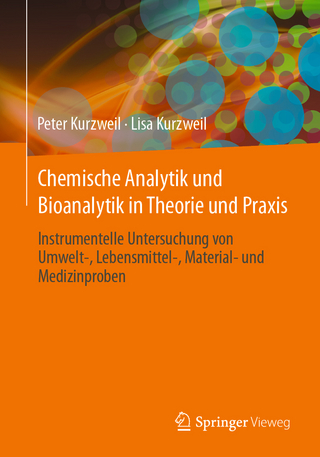Self-Organization of Molecular Systems
The NATO ARW "Molecular Self-Organization in Micro-, Nano-, and Macro- Dimensions: From Molecules to Water, to Nanoparticles, DNA and Proteins" to commemorate Professor Alexander S. Davydov was held in Kiev, Ukraine, on 8-12 June, 2008, at the Bogolyubov Institute for Theoretical Physics of the National Academy of Sciences of Ukraine. Theobjective ofthisNATOARWistounveilandformulatetheprincipalfeatures that govern myriads of the molecular self-organization processes in micro-, nano-, and macro-dimensions from the following key representatives such as liquid - ter and aqueous solutions, and molecular liquids, nanodots, nanoparticles including gold, solitons, biomolecules such as DNA and proteins, biopolymers and bios- sors, catalysis, molecular modeling, molecular devices, and thin ?lms, and to offer another, more advanced directions in computational, experimental, and technolo- cal areas of nano- and bioscience towards engineering novel and powerful molecular self-organized assemblies with tailored properties. Nanoscience is indeed one of the most important research and development fr- tiers in modern science.
Simplistically, nanoscience is the science of small particles of materials of a size of nanometre. Molecular nanoscience and nanotechnology have brought to us the unprecedented experimental control of the structure of matter with novel extraordinary properties that open new horizons and new opportunities, and new ways to make things, particularly in our everyday life, to heal our bodies, and to care of the environment. Unfortunately, they have also brought unwelcome advances in weaponry and opened yet more ways to foul up the world on an en- mous scale.
Recent Progress on Small Hydrogen Molecular Ions.- FDTD Studies of Metallic Nanoparticle Systems.- Exploring the Nitric Oxide Detoxification Mechanism of Mycobacterium tuberculosis Truncated Haemoglobin N.- Complex Symmetry, Jordan Blocks and Microscopic Self-organization.- Directed Transport of the Davydov Solitons by Unbiased a.c. Forces.- Some Properties of Solitons.- Spectral Effects of Resonance Dynamic Intermolecular Interaction for Crystalline Carboxylic Acids at Temperature Phase Transitions.- Linear Augmented Cylindrical Wave Method for Electronic Structure of Isolated, Embedded, and Double-Walled Nanotubes.- Anharmonicity and Soliton-Mediated Transport: Thermal Solitons, Solectrons and Electric Transport in Nonlinear Conducting Lattices.- How Exponential Type Orbitals Recently Became a Viable Basis Set Choice in Molecular Electronic Structure Work and When to Use Them.- Cation Hydrolysis Phenomenon in Aqueous Solution: Towards Understanding It by Computer Simulations.- Davydov's Solitons in DNA.- Potential Energy Surfaces for Reaction Catalyzed by Metalloenzymes from Quantum Chemical Computations.- Gold in Hydrogen Bonding Motif—Fragments of Essay.- Interatomic Potential for Platinum and Self-Diffusion on Pt(111) Surface by Molecular-Dynamics Simulation.- Gap-Townes Solitons and Delocalizing Transitions of Multidimensional Bose–Einstein Condensates in Optical Lattices.- Hydration Effects on Photophysical Properties of Collagen.- Cluster Quantum Chemical Study of the Grignard Reagent Formation.
| Erscheint lt. Verlag | 2.6.2009 |
|---|---|
| Reihe/Serie | NATO Science for Peace and Security Series |
| Zusatzinfo | XIV, 400 p. |
| Verlagsort | Dordrecht |
| Sprache | englisch |
| Maße | 155 x 235 mm |
| Themenwelt | Naturwissenschaften ► Biologie ► Biochemie |
| Naturwissenschaften ► Chemie ► Physikalische Chemie | |
| Naturwissenschaften ► Physik / Astronomie ► Atom- / Kern- / Molekularphysik | |
| Technik | |
| ISBN-10 | 90-481-2482-4 / 9048124824 |
| ISBN-13 | 978-90-481-2482-4 / 9789048124824 |
| Zustand | Neuware |
| Haben Sie eine Frage zum Produkt? |
aus dem Bereich




